#ming vases
Explore tagged Tumblr posts
Text
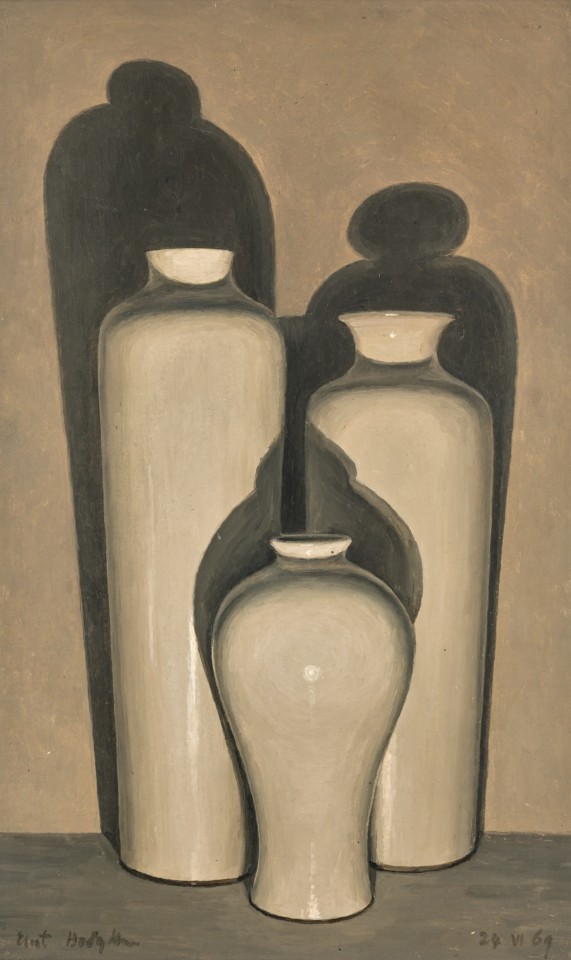
Eliot Hodgkin (British, 1905-1987), Three Ming Vases by Lamplight, 24 June 1969. Oil on board, 16¼ x 10 in.
203 notes
·
View notes
Text
my updated dragon 🐉
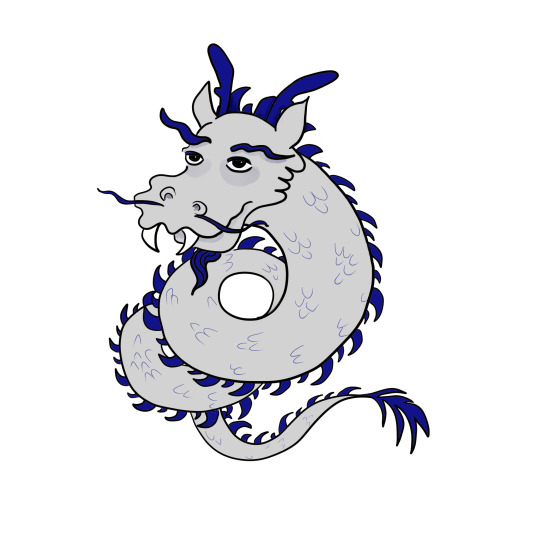
i was inspired by the Ming era vases. And it's also the year of the dragon.
#digital drawing#chinese dragon#digital art#dragon art#Dragon#ming vases#ming era#cartoon#cartoon art#cartoony art#nostaligiacore#learning to draw#learning to draw again#digital painting#digital illustration#illustration
4 notes
·
View notes
Text

Hu Ming - Ancient Vase
229 notes
·
View notes
Text

24 notes
·
View notes
Text
"Policed to Meet You"

Pop Tate's new hair looks rather squiggly. Not going to Archie's buck teeth anymore. Reconsidered the amount of ice cream needed for a large party.

Archie's shoulders now bumping about, I guess.

Ming out, Manchu in. New bowtie colors. Counter to the manner things get washed out in one color-- see bridge here.

Recolor Veronica's dress.

Not coloring the soles of Archie's shoes anymore.

The soot in face leads to a reference they don't much want to keep. Though now the replacement just kind of sits non-sensically.

Puzzling question on Lodge's new front of suit color. It had not been blackened in the sooty exhaust scene.

Maybe the foreign legion reference gets dropped as a "duplicatable" appraisal? It was stuffed in anyways.
#Archie Comics#Archie Andrews#Pop Tate#Hiram Lodge#Veronica Lodge#Jughead#Park bench#Bridge#Hair#Side hair#Ol' Betsy#Exhaust fumes#Soot#Amos and Andy#Traffic cop#Ming Vase#Manchu Vase#Foreign Legion#J.P. Lodge#Recoloring#Hues#Indicia filler#Samm Schwartz#1957#Gallons#Continuity error#Teeth
3 notes
·
View notes
Text

#xiao zhan#so simple and yet so effective#i really loved this hair length on him#i also love the subtle design on the shirt#reminds me of this one meiping vase from the ming dynasty
3 notes
·
View notes
Text
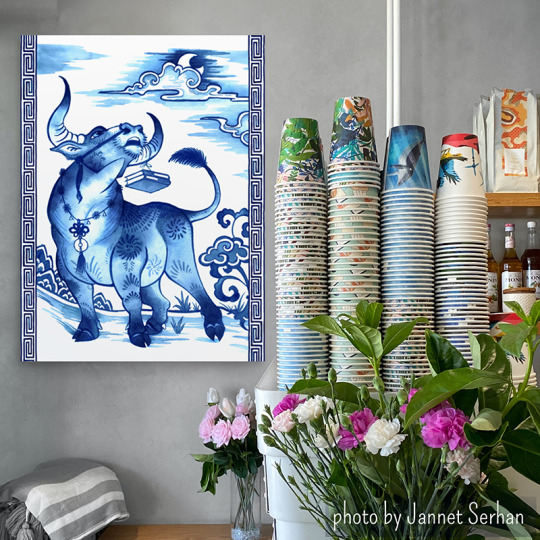


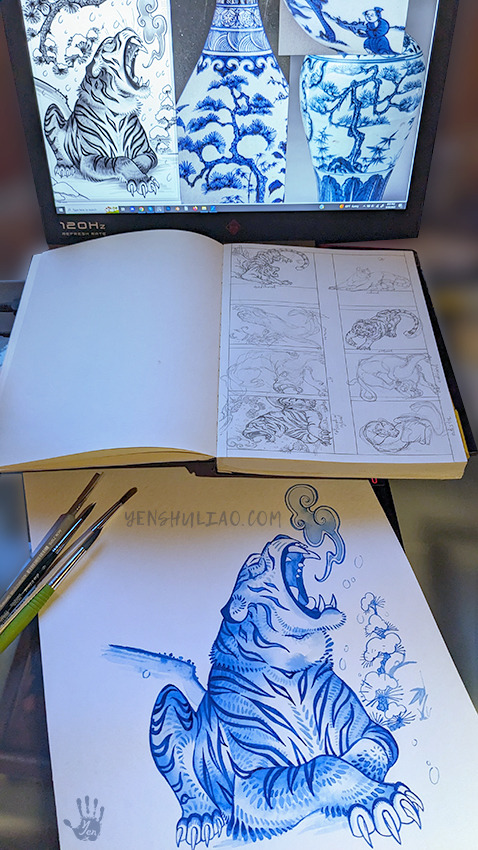
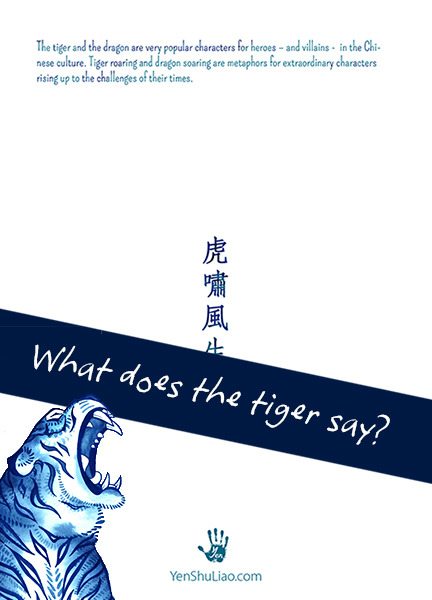
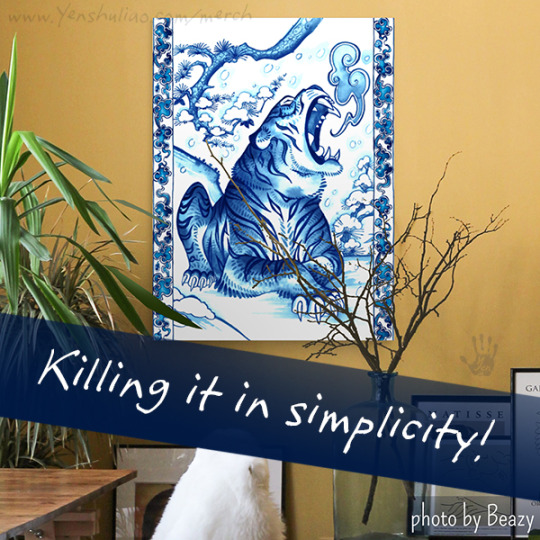
One never knows what one might find in the mind field... 🐯
#animal art#tiger art#watercolour art#chinese zodiac#year of the tiger#lunar new year#ming vase#blue and white
9 notes
·
View notes
Text

Wonder which Italian dynasty this belongs too,
49 notes
·
View notes
Text
Somewhere in Prince John’s head, where brain cells ought to be, there’s a tiny squad of cheerleader lions jumping up and down chanting “PJ! PJ! PJ!” over and over again.
#Prince John#disney robin hood#it really do be like that#this man has an ego like a ming vase; large yet fragile#mostly large#he really is a very silly man#but that’s why we love him
0 notes
Photo










La semaine dernière c'était direction la Chine, pour créer de délicates porcelaines bleues et blanches.
0 notes
Text

started to draw digitally. i was insipred by the vases of the Chineese Ming-Era.
3 notes
·
View notes
Text
My biggest gardening tip is that if you have $100 to spend on perennial plants you should aim closer to getting twenty little perennials than three or four big perennials. Planting four $25 plants will have a very small impact visually and you’ll be way too precious about them. Five small plants of the same species will make a bigger visual impact than one large plant of the same species. Plants are living things that you’re planting outside in the weather. You should be buying plants with the understanding that they are closer to folding chairs than Ming vases. If you spend $25 on a plant and accidentally step on it, you haven’t killed the plant but you’ve probably broken off about $12 worth of stems. If you step on a $5 plant you’ve caused like $2 worth of damage and it was probably young anyway so it might push out enough new growth to fill back in by the end of the season. You’d have to outright kill 5 of your $5 plants to equal losing one $25 plant. You will always kill some of your plants, or at least they won’t all thrive. Better to lose a $5 plant than a $25 plant.
Also plants grow, usually quickly. Very few perennial plants look good their first year in the ground, buying a bigger plant doesn’t really change that. Most of the time the difference between buying a gallon perennial and a pint perennial is that you dig a bigger hole for the gallon, you pour more water on the gallon, and you watch it look bad more closely.
All I’m saying is that it recently came to my attention that people when people complain about gardening being expensive it’s because they are spending $600 on landscaping that, frankly, looks like nothing bc they’re buying $50 to $100 plants.
790 notes
·
View notes
Text
The 4 approaches to “orphaned etymology” problems in fiction
1. Obviously we can’t call it French toast if there’s no France so we’re just gonna replace it with something else.
2. The word abattoir sounds too French so it wouldn’t make sense for it to be here without a France. Even though we use English without there being an England.
3. This is called a Ming vase because when you tap it it makes a “Ming!” sound.
4. I am JRR Tolkien and every single word I write has a fictional etymology attached to it that I am translating into English for your convenience.
21K notes
·
View notes
Text
'...“It’s fun playing bad, but actually he’s not,” the actor says, smiling as he reflects on his character, Crowley. “He’s a villain with a heart. The amount of really evil things he does are vanishingly small.”
...As it always has, “Good Omens” dissects the view of good and evil as absolutes, showing viewers that they are not as separate as we were led to believe growing up. Aziraphale and Crowley’s long-standing union is proof of this. The show also urges people to look at what defines our own humanity. For Tennant — who opted to wear a T-shirt emblazoned with the words “Leave trans kids alone you absolute freaks” during a photocall for Season 2 — these themes are more important now than ever before.
“In this society that we’re currently living in, where polarization seems ever more present, fierce and difficult to navigate. Negotiation feels like a dirty word at times,” he says, earnestly. “This is a show about negotiation. Two extremes finding common ground and making their world a better place through it. Making life easier, kinder and better. If that’s the sort of super objective of the show, then I can’t think of anything more timely, relevant or apt for the rather fractious times we’re living in.”
“Good Omens” is back by popular demand for another season. How does it feel?
It’s lovely. Whenever you send something out into the world, you never quite know how it will land. Especially with this, because it was this beloved book that existed, and that creates an extra tension that you might break some dreams. But it really exploded. I guess we were helped by the fact that we had Neil Gaiman with us, so you couldn’t really quibble too much with the decisions that were being made. The reception was, and continues to be, overwhelming.
Now that you’re no longer bound by the original material that people did, perhaps, feel a sense of ownership over, does the new content for Season 2 come with a sense of freedom for you? This is uncharted territory, of sorts.
That’s an interesting point. I didn’t know the book when I got the script. It was only after that I discovered the worlds of passion that this book had incited. Because I came to it that way, perhaps it was easier. I found liberation from that, to an extent. For me, it was always a character that existed in a script. At first, I didn’t have that extra baggage of expectation, but I acquired it in the run-up to Season 1 being released… the sense that suddenly we were carrying a ming vase across a minefield.
In Season 2, we still have Neil and we also have some of the ideas that he and Terry had discussed. During the filming of the first one, Neil would drop little hints about the notions they had for a prospective sequel, the title of which would have been “668: The Neighbour of the Beast,” which is a pretty solid gag to base a book around. Indeed there were elements like Gabriel and the Angels, who don’t feature in the book, that were going to feature in a sequel. They were brought forward into Season 1. So, even in the new episodes, we’re not entirely leaving behind the Terry Pratchett-ness of it all.
It’s great to see yourself and Michael Sheen reunited on screen as these characters. Fans will have also watched you pair up for Season 3 of “Staged.” You’re quite the dynamic duo. What do you think is the magic ingredient that makes the two of you such a good match?
It’s a slightly alchemical thing. We knew each other in passing before, but not well. We were in a film together [“Bright Young Things,” 1993] but we’d never shared a scene. It was a bit of a roll of the dice when we turned up at the read-through for “Good Omens.” I think a lot comes from the writing, as we were both given some pretty juicy material to work with. Those characters are beloved for a reason because there’s something magical about them and the way they complete each other. Also, I think we’re quite similar actors in the way we like to work and how we bounce off each other.
Does the shorthand and trust the two of you have built up now enable you to take more risks on-screen?
Yes, probably. I suppose the more you know someone, the more you trust someone. You don’t have to worry about how an idea might be received and you can help each other out with a more honest opinion than might be the case if you were, you know, dancing around each other’s nervous egos. Enjoying being in someone’s orbit and company is a positive experience. It makes going to work feel pleasant, productive, and creative. The more creative you can be, the better the work is. I don’t think it’s necessarily a given that an off-screen relationship will feed into an on-screen one in a positive or negative way. You can play some very intimate moments with someone you barely know. Acting is a peculiar little contract, in that respect. But it’s disproportionately pleasurable going to work when it’s with a mate.
Fans have long discussed the nature of Crowley and Aziraphale’s relationship. In Season 2, we see several of the characters debate whether the two are an item, prompting them to look at their union and decipher what it is. How would you describe their relationship?
They are utterly co-dependent. There’s no one else having the experience that they are having and they’ve only got each other to empathize with. It’s a very specific set of circumstances they’ve been dealt. In this season, we see them way back at the creation of everything. They’ve known each other a long time and they’ve had to rely on each other more and more. They can’t really exist one without the other and are bound together through eternity. Crowley and Aziraphale definitely come at the relationship with different perspectives, in terms of what they’re willing to admit to the relationship being. I don’t think we can entirely interpret it in human terms, I think that’s fair to say.
Yet fans are trying to do just that. Do you view it as beyond romantic or any other labels, in the sense that it’s an eternal force?
It’s lovely [that fans discuss it] but you think, be careful what you wish for. If you’re willing for a relationship to go in a certain way or for characters to end up in some sort of utopian future, then the story is over. Remember what happened to “Moonlighting,” that’s all I’m saying! [Laughs]
Your father-in-law, Peter Davison, and your son, Ty Tennant, play biblical father-and-son duo Job and Ennon in Episode 2. In a Tumblr Q&A, Neil Gaiman said that he didn’t know who Ty’s family was when he cast him. When did you become aware that Ty had auditioned?
I don’t know how that happened. I do a bunch of self-tapes with Ty, but I don’t think I did this one with him because I was out of town filming “Good Omens.” He certainly wasn’t cast before we started shooting. There were two moments during filming where Neil bowled up to me and said, “Guess, who we’ve cast?” Ty definitely auditioned and, as I understand it, they would tell me, he was the best. I certainly imagine he could only possibly have been the best person for the job. He is really good in it, so I don’t doubt that’s true. And then my father-in-law showed up, as well, which was another delicious treat. In the same episode and the same family! It was pretty weird. I have worked with both of them on other projects, but never altogether.
There’s a “Doctor Who” cameo, of sorts, in Episode 5, when Aziraphale uses a rare annual about the series as a bartering tool. In reality, you’ll be reprising your Time Lord role on screen later this year in three special episodes to mark the 60th anniversary. Did you always feel you’d return to “Doctor Who” at some point?
There’s a precedent for people who have been in the series to return for a multi-doctor show, which is lovely. I did it myself for the 50th anniversary in 2013, and I had a wonderful time with Matt [Smith]. Then, to have John Hurt with us, as well, was a little treat. But I certainly would never have imagined that I’d be back in “Doctor Who” full-time, as it were, and sort of back doing the same job I did all those years ago. It was like being given this delightful, surprise present. Russell T Davies was back as showrunner, Catherine Tate [former on-screen companion] was back, and it was sort of like the last decade and a half hadn’t happened.
Going forward, Ncuti Gatwa will be taking over as the new Doctor. Have you given him any advice while passing the baton?
Oh God, what a force of nature. I’ve caught a little bit of him at work and it’s pretty exciting. I mean, what advice would you give someone? You can see Ncuti has so much talent and energy. He’s so inspired and charismatic. The thing about something like this is: it’s the peripherals, it’s not the job. It’s the other stuff that comes with it, that I didn’t see coming. It’s a show that has so much focus and enthusiasm on it. It’s not like Ncuti hasn’t been in a massive Netflix series [“Sex Education,”] but “Doctor Who” is on a slightly different level. It’s cross-generational, international, and has so much history, that it feels like it belongs to everyone.
To be at the center of the show is wonderful and humbling, but also a bit overwhelming and terrifying. It doesn’t come without some difficulties, such as the immediate loss of anonymity. It takes a bit of getting used to if that’s not been your life up to that point. I was very lucky that when I joined, Billie Piper [who portrayed on-screen companion, Rose] was still there. She’d lived in a glare of publicity since she was 14, so she was a great guide for how to live life under that kind of scrutiny. I owe a degree of sanity to Billie.
Your characters are revered by a few different fandoms. Sci-fi fandoms are especially passionate and loyal. What is it like being on the end of that? I imagine it’s a lot to hold.
Yes, certainly. Having been a fan of “Doctor Who” since I was a tiny kid, you’re aware of how much it means because you’re aware of how much it meant to you. My now father-in-law [who portrayed Doctor Who in the 80s] is someone I used to draw in comic strips when I was a kid. That’s quite peculiar! It’s a difficult balance because on one end, you have to protect your own space, and there aren’t really any lessons in that. That does take a bit of trial and error, to an extent, and it’s something that you’re sometimes having to do quite publicly. But, it is an honor and a privilege, without a doubt. As you’ve said, it means so much to people and you want to be worthy of that. You have to acknowledge that and be careful with it. Some days that’s tough, if you’re not in the mood.
I know you’re returning to the stage later this year to portray Macbeth. You’ve previously voiced the role for BBC Sounds, but how are you feeling about taking on the character in the theater?
I’m really excited about it. It’s been a while since I’ve done Shakespeare. It’s very thrilling but equally — and this analogy probably doesn’t stretch — it’s like when someone prepares for an Olympic event. It does feel like a bit of a mountain and, yeah, you’re daring to set yourself up against some fairly worthy competition from down the years. That’s both the challenge and the horror of doing these types of things. We’ve got a great director, Max Webster, who recently did “Life of Pi.” He’s full of big ideas. It’s going to be exciting, thrilling, and a little bit scary. I’m just going to take a deep breath.
Before we part ways, let’s discuss the future of “Good Omens.” Gaiman has said that he already has ideas for Season 3, should it happen. If you were to do another season, is there anyone in particular you’d love to work with next time around or anything specific you’d like to see happen for Crowley?
Oh, Neil Gaiman knows exactly where he wants to take it. If you’re working with people like Gaiman, I wouldn’t try to tamper with that creative void. Were he to ask my opinion, that would be a different thing, but I can’t imagine he would. He’s known these characters longer than me and what’s interesting is what he does with them. That’s the bit that I’m desperate to know. I do know where Crowley might end up next, but it would be very wrong if I told you.
[At this point, Tennant picks up a pencil and starts writing on a hotel pad of paper.]
I thought you were going to write it down for me then. Perhaps like a clandestine meeting on a bench in St James’ Park, but instead you’d write the information down and slide it across the table…
I should have done! I was drawing a line, which obviously, psychologically, I was thinking, “Say no more. You’re too tempted to reveal a secret!” It was my subconscious going “Shut the fuck up!”
#David Tennant#Michael Sheen#Good Omens#Neil Gaiman#Terry Pratchett#Ty Tennant#Peter Davison#Aziraphale#Crowley#Doctor Who#Macbeth#Ncuti Gatwa#Job#Ennon#Bright Young Things#Series 2#Matt Smith#John Hurt#Russell T. Davies#Catherine Tate#Max Webster#Life of Pi#Sex Education#Billie Piper#Rose Tyler#BBC Sounds
3K notes
·
View notes
Text
April 20, Beijing, China, National Museum of China/中国国家博物馆 (Part 5 – Ancient Chinese Porcelain exhibition/中国古代瓷器展):
First post of the year, gotta start with something good: this is a rather famous vase from Qianlong era of Qing dynasty (1644 - 1911). It's made in the suantouping/蒜头瓶 (lit. "garlic-head vase") shape, and decorated with falangcai/珐琅彩 (basically cloisonné but done on porcelain instead of metal). The design features a nice combination of traditional Chinese chanzhihua/缠枝花 motifs (traditionally this continuous plant motif symbolizes longevity) and European art influence, specifically from rococo. This is interesting as rococo was also influenced by Chinese porcelain, making this vase another example of cultural influence going both ways.

As mentioned in my previous announcement post, my visit to the National Museum of China was very brief, everything took place in the span of one day (plus traveling to and from Beijing), please pardon the picture quality.
And from here on I will be going in chronological order. Below is an urn from the Northern Dynasties (439 - 581 AD). This urn was decorated with lotus petals all around, and was specifically a type of grave good, not made to be used by the living. Lotuses are a commonly used symbol in funerary rites due to its association with Sukhavati (Sanskrit: सुखावती; referred to as "极乐世界" or "Land of Bliss" in Chinese) in Mahayana Buddhism.

Another urn, this time from the Sui dynasty (581 - 618 AD) Shouzhou kiln/寿州窑. This urn may also have been grave good, as evidenced by the numerous Buddhist symbols all around.

Left: a small Sui-era vessel, found in a tomb. It's probably also a grave good, because of its pointy design (imagine holding that).
Right: a group of small Sui-era grave goods, these were tiny and adorable


In the middle is a Tang dynasty (618 - 907 AD) pitcher, made by the Lushan kiln/鲁山窑. This pitcher displays Lushan wares' characteristic blueish glaze, where the blue comes from different concentrations of iron oxides.

Left: a Northern Song dynasty (960 - 1127) white-glazed wine vessel called a meiping/梅瓶 (lit. "plum vase"), but in Song dynasty it was called a jingping/经瓶.
Middle: a Northern Song era white-glazed Ding ware/定窑 plate decorated with the double fish motif.
Right: this one is pretty cute, it's a container for weiqi/围棋 pieces that's shaped like a drum, made by Yaozhou kiln/耀州窑.



Left: forgot to take a picture of the placard, but my guess is that it's a bamboo-necked celadon-glazed Longquan ware/龙泉窑 vase (I might be wrong).
Right: a small Southern Song dynasty (1127 - 1279) Ge ware/哥窑 bixi/笔洗. Bixi are containers used to rinse traditional brushes. This bixi has the crackled glaze that's characteristic of Ge wares.


Left: a small haitang/海棠 flower-shaped celadon-glazed lidded container box called a taohe/套盒, made by Southern Song dynasty guan kiln/官窑 (guan/官 means "official", so "guan kiln" is best understood as the kiln that's run by the imperial court; this is important as later dynasties may have their own guan kilns). These containers can hold various small objects including food, and are stackable.
Right: a Song-era haitang-shaped rose purple flower pot, made by Jun kiln/钧窑. Jun wares are known for their glaze colors, which shift and change according to the firing temperature, this is known as yaobian/窑变 (aka kiln transmutation or "flambé"). This particular flower pot became part of Qing imperial court's collection later on.


A Yuan dynasty (1206 - 1368) qinghua/青花 ("blue and white") porcelain pot, decorated with dragons. The blue color in the famous qinghua porcelain comes from cobalt blue pigment in the underglaze.

A Yuan-era qinghua porcelain vase decorated with a flying fenghuang:

Two Ming dynasty (1368 - 1644) tall-footed bowls, the left one has a glaze known as "sweet white glaze" (甜白釉), since this shade of white was likened to the white of crystal sugar; the reign mark indicated that it was made during the Yongle era of Ming dynasty. The bowl on the right has the peacock blue glaze (孔雀蓝釉), and the reign mark indicated that it was made during the Xuande era of Ming dynasty. Reign marks are markings that indicate the dynasty and era during which a piece was made.

A side note on era names or nianhao/年号: nianhao was a way of identifying years in imperial China and was usually decided by the reigning emperor at the time. One emperor may have multiple era names during their reign if they so choose, however since Ming and Qing dynasty mostly have just one era name per emperor, Ming and Qing emperors are often referred to simply by the era name they used, for example Yongle Emperor (temple name Emperor Chengzu of Ming) or Qianlong Emperor (temple name Emperor Gaozong of Qing). Depending on the context, usage of a Ming or Qing era name may refer to the time period during which an emperor reigned, the emperor who used the era name, or even both.
Three Ming-era monochrome (called danseyou/单色釉 in Chinese) porcelain plates. Monochrome porcelain became popular in Song dynasty, and has been popular ever since, but overall three dynasties were the most famous for their production of monochrome porcelain: Song dynasty, Ming dynasty, and Qing dynasty (1644 - 1911). Recently monochrome porcelain has been gaining popularity again, since their vibrant colors fit into modern aesthetics surprisingly well.

A wall of monochrome porcelain plates, illustrating the effect of different elements and firing temperatures on glaze color.

A set of wares that may be found in a study, made in the Kangxi era of Qing dynasty (1662 - 1722). The glaze used here is quite famous, called jiangdouhong/豇豆红 (aka cowpea red), created by applying copper red glaze in high temperatures. The end result is notoriously hard to control, so some pieces may turn out to have multiple colors, mostly the shade of red as seen below and apple green. The left and back pieces are both small decorative vases (for the longest time I thought the one on the left was an upside-down bowl......lol), the small box in the front is a seal paste box, and the flat bowl on the right is a bixi.

Left: red and blue yaobian vase, made during the Yongzheng era of Qing dynasty (1723 - 1735); unfortunately due to the angle here, you can only see a little bit of the blue streak running down the front. The colors are so vibrant here that this kind of yaobian has earned the nickname of "flaming red"/火焰红.
Right: a langyaohong/郎窑红 (also called "sang de boeuf" or "oxblood") vase, made during the Kangxi era of Qing dynasty. Langyaohong glaze is known for its deeply red color, hence the names that relate it to blood.

A Kangxi era blue glazed gilt porcelain vase. I love the intricate interconnected lotus patterns (chanzhilianwen/缠枝��纹) here. I didn't have time to take a picture of the placard so it literally took hours of pulling my hair out reverse image searching to find out when (which era) this vase was made................. (btw the text in the back refers to the painting in the background, not this vase)
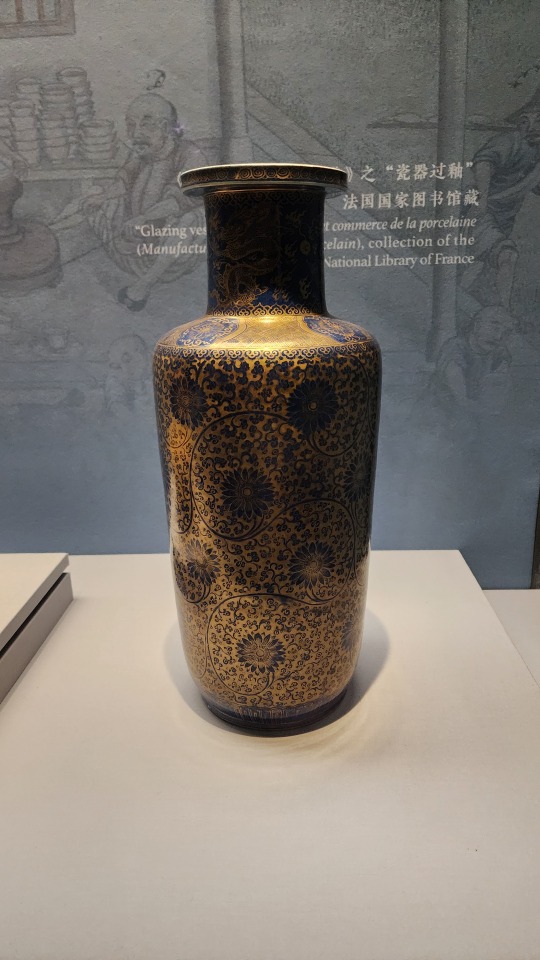
Left: a youlihong/釉里红 vessel that's shaped like an apple, so it's quite literally named a pingguozun/苹果尊. This shape is rather unique to the Kangxi era. Youlihong (lit: "red inside glaze") is basically a red copper oxide underglaze.
Middle: a youlihong vase made in the Yongzheng era.
Right: a larger vase made in the Yongzheng era that combines qinghua underglaze and youlihong underglaze in one piece.

This giant qinghua vase from the Qianlong era of Qing dynasty (1736 - 1795) was made in the shape of Shang and Zhou dynasty ancient bronze ritual vessel named gu/觚. This is also one of the few pieces produced in history that had the name of the potter attached to it. The potter who made this vase was Tang Ying/唐英, and he was the superintendent who oversaw imperial porcelain production in Jingdezhen/景德镇 (basically the Ming and Qing dynasty guan kiln) during the Yongzheng era and the Qianlong era. Together with the Kangxi era, these three Qing dynasty eras are collectively called "清三代", or "the three Qing generations (of emperors)", this was the second height of porcelain making in Chinese history after the "five great kilns"/"五大窑" of Song dynasty.

A column shaped openwork fencai/粉彩 incense holder from Qianlong era, where fencai is basically overglaze enamel decoration that falls under famille rose.

Left: a Qianlong era green fencai vase that feature kaiguang/开光, which were window or panel-like designs on the piece where scenes may be painted. This particular vase also displays poetry by Qianlong Emperor himself.
Middle: a fencai shuanglianping/双联瓶 made during the Jiaqing era of Qing dynasty (1796 - 1820). Shuanglianping are conjoined vases that symbolize the coming together of matching talents or generally good things.
Right: a Qianlong era gourd-shaped doucai/斗彩 vase with kaiguang. Doucai combines both underglaze decorations and overglaze decorations.

I want to draw special attention to this leaf-shaped fencai cup in the middle that was made in the Guangxu era of Qing dynasty (1875 - 1908). The "leaf" part is actually a lotus flower, but the cool thing about it is that the green stem part is a built-in straw, so this is a highly decorative porcelain straw cup. I really do hope there are cheaper modern replicas of this cup sold somewhere, I want one
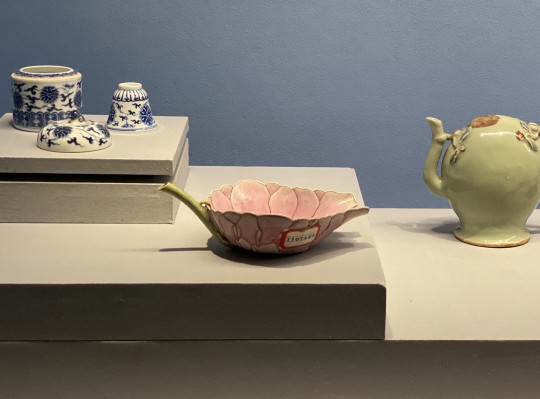
Finally, to wrap up this exhibition, here's an arrangement to show how these different porcelain pieces would be utilized in a traditional study room.

#2024 china#beijing#china#national museum of china#chinese porcelain#chinese art#chinese history#chinese culture#porcelain#ceramics#art#culture#history
97 notes
·
View notes
